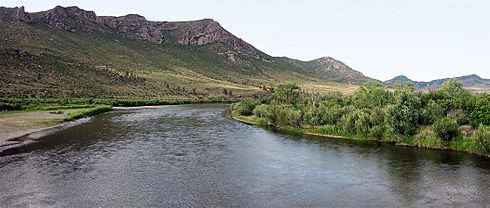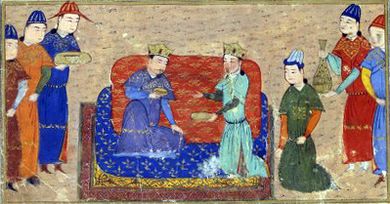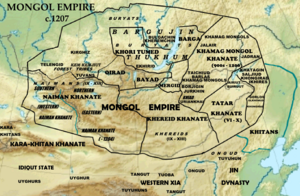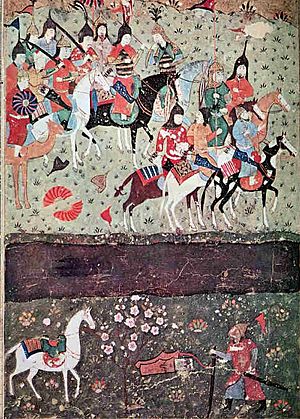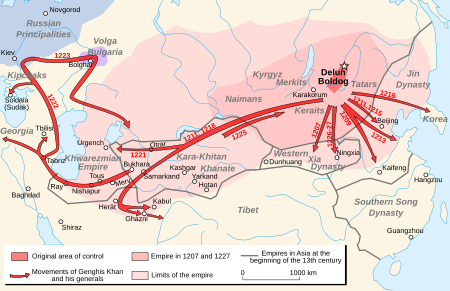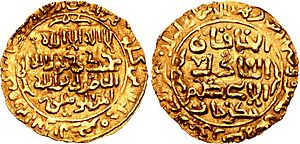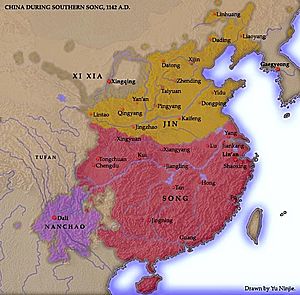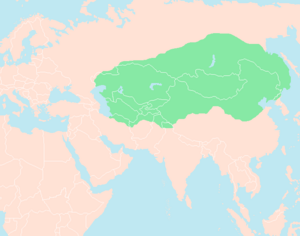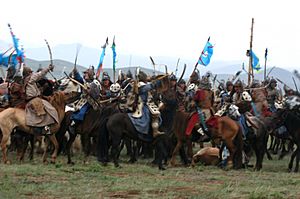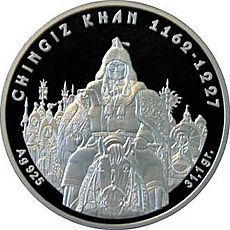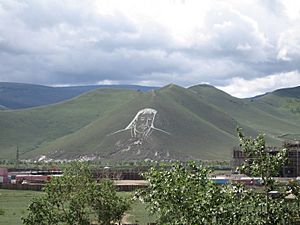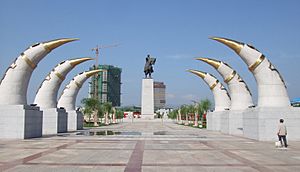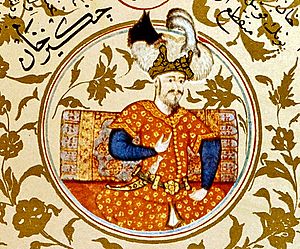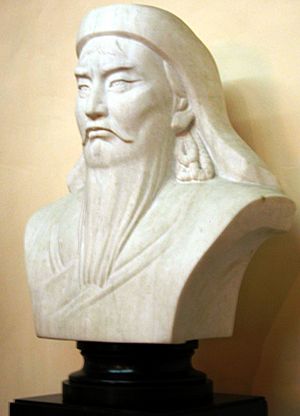Genghis Khan facts for kids
Quick facts for kids Genghis Khan |
|||||||||||||
|---|---|---|---|---|---|---|---|---|---|---|---|---|---|
|
|||||||||||||

Genghis Khan as portrayed in a 14th-century Yuan era album; now located in the National Palace Museum, Taipei, Taiwan. The original version was in black and white; produced by the Mongol painter Ho-li-hosun in 1278 under the commission of Kublai Khan.
|
|||||||||||||
| Great Khan of the Mongol Empire | |||||||||||||
| Reign | Spring 1206 – 25 August, 1227 | ||||||||||||
| Coronation | Spring 1206 in a Kurultai at the Onon River, in modern-day Mongolia | ||||||||||||
| Successor | Tolui (as regent) Ögedei Khan |
||||||||||||
| Born | Temüjin c. 1162 Khentii Mountains, Khamag Mongol |
||||||||||||
| Died | August 25, 1227 Xingqing, Western Xia |
||||||||||||
| Burial | Unknown (presumptively Ikh Khorig, Burkhan Khaldun, Khentii Province) |
||||||||||||
| Spouse |
|
||||||||||||
| Issue | |||||||||||||
|
|||||||||||||
| House | Borjigin | ||||||||||||
| Dynasty | Genghisid | ||||||||||||
| Father | Yesügei | ||||||||||||
| Mother | Hoelun | ||||||||||||
| Religion | Tengrism | ||||||||||||
Genghis Khan (born Temüjin; around 1162 – August 25, 1227), also known as Chinggis Khan, was a powerful leader. He founded the Mongol Empire, which became the largest land empire in history. He spent most of his life bringing together the different Mongol tribes. Then, he led many military campaigns that conquered large parts of China and Central Asia.
Born as Temüjin, he was the oldest child of Yesugei, a Mongol chieftain, and his wife Hoelun. When Temüjin was eight, his father died. His family was left alone by their tribe in the Mongol steppe. Temüjin slowly gathered a small group of followers. He allied with Jamukha and Toghrul, two other Mongol chieftains. These alliances later broke, but Temüjin defeated both. He became the sole ruler of all Mongol tribes. In 1206, he officially took the name Genghis Khan.
With the tribes united, Genghis Khan expanded his empire. He took control of the Western Xia state by 1211. Then, he invaded the Jin dynasty in northern China. Mongol forces also took over the Qara Khitai khanate in 1218. This allowed Genghis Khan to invade the Khwarazmian Empire the next year. His armies destroyed the Khwarazmian state. They also reached as far as Georgia and Kievan Rus'. Genghis Khan died in 1227 while fighting the Western Xia. His third son, Ögedei, became the next ruler.
Genghis Khan's campaigns caused much destruction and many deaths. However, the Mongol army he built was known for being flexible, disciplined, and organized. His empire was based on merit, meaning people were chosen for their skills, not their family. Genghis Khan also created the Mongol legal system. He promoted religious tolerance and encouraged trade across Eurasia through the Pax Mongolica. Today, he is honored in Mongolia as a symbol of their national identity.
Contents
- Understanding Genghis Khan's Name and Titles
- Genghis Khan's Early Life and Family
- Genghis Khan's Rise to Power
- Genghis Khan's Major Military Campaigns (1206–1227)
- Genghis Khan's Death and Succession
- How Genghis Khan Organized His Empire
- Genghis Khan's Impact on History
- Genghis Khan in Art and Culture
- See also
Understanding Genghis Khan's Name and Titles
What Does Genghis Khan Mean?
Genghis Khan is an important title that means "universal ruler." It comes from an older Mongol word for a clan chief, Khan. The word "Genghis" might come from a Turkic word meaning "sea." So, "oceanic ruler" means his rule was vast and total, like the ocean.
It's tricky to write original Mongolian names in English. Many different spellings exist. The most common spelling, Genghis, comes from the Mongolian ᠴᠢᠩᠭᠢᠰ ᠬᠠᠭᠠᠨ. Other spellings you might see include Chinggis or Jinghis.
The Birth Name: Temüjin
Genghis Khan's birth name was Temüjin ᠲᠡᠮᠦᠵᠢᠨ. Some stories say his father named him after a Tatar chief he had captured. The name Temüjin is also linked to the word for "blacksmith" in some languages.
Special Names After His Death
When Genghis Khan's grandson, Kublai Khan, started the Yuan dynasty in 1271, he gave his grandfather special names. These names were Taizu, meaning "Supreme Ancestor," and Shengwu huangdi, meaning "Holy-Martial Emperor." These were honorary titles given after his death.
Genghis Khan's Early Life and Family
When and Where Was Genghis Khan Born?
Historians aren't sure exactly when Temüjin was born. It was likely between 1155 and 1167. Some traditions say it was in the Year of the Pig, which could be 1155 or 1167. Many major historical records point to 1162. His birthplace is also debated, but it was likely near the Onon River in modern-day Mongolia.
Temüjin was born into the Borjigin clan. His father, Yesügei, was a chieftain. His mother, Hoelun, was from the Olkhonud clan. She had been taken by Yesügei from her first husband. Temüjin had three younger brothers: Qasar, Hachiun, and Temüge. He also had two half-brothers, Behter and Belgutei, from his father's second wife. They grew up learning to ride horses and shoot bows.
A Young Leader's Challenges
When Temüjin was eight, his father, Yesügei, arranged for him to marry Börte. She was the daughter of a chieftain from the Onggirat tribe. Temüjin had to stay with Börte's family to work for her bride price. While Yesügei was riding home, he was poisoned by some Tatars. He died soon after, leaving Temüjin to return home.
Yesügei's death caused his people to split apart. Temüjin was only about ten years old, too young to rule. Most of Yesügei's people left his family and joined another group, the Tayichiuds. Hoelun's family had to live a much harder life. They gathered roots and nuts, hunted small animals, and fished to survive.
As the children grew, tensions rose between Temüjin and his half-brother Behter. Both had claims to be their father's heir. Temüjin and his younger brother Qasar ambushed and killed Behter. This was a forbidden act. Behter's younger brother, Belgutei, did not seek revenge. He became one of Temüjin's most trusted followers. Around this time, Temüjin became close friends with Jamukha. They swore an oath to be blood brothers.
Because his family lacked allies, Temüjin was captured several times. Once, he was caught by the Tayichiuds. He escaped by hiding in a river and then in a man's tent. This man, Sorkan-Shira, helped him escape. Another time, a young man named Bo'orchu helped him get back stolen horses. Bo'orchu then joined Temüjin as his first personal companion. These stories show how Temüjin's personal charm helped him gain followers.
Genghis Khan's Rise to Power
Forming Alliances and Early Battles
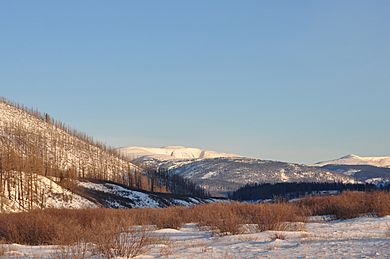
When Temüjin was fifteen, he returned to Dei Sechen to marry Börte. Dei Sechen was happy to see him and agreed to the marriage. Temüjin then sought help from Toghrul, the khan of the Kerait tribe. Toghrul had been friends with Temüjin's father. Toghrul ruled a large area and had many warriors. He welcomed Temüjin and offered him protection. Temüjin began to gather his own followers.
Soon after, about 300 Merkits attacked Temüjin's camp to get revenge for his father's actions. Temüjin and his brothers hid on Burkhan Khaldun mountain. But Börte and his stepmother Sochigel were taken away. Börte was given to a Merkit man. Temüjin asked Toghrul and his childhood friend Jamukha for help. Both chiefs sent armies of 20,000 warriors. They quickly won the fight. Börte, who was pregnant, was rescued. She soon gave birth to a son, Jochi. Temüjin raised Jochi as his own, but some always questioned Jochi's true father.
Temüjin and Jamukha stayed together for a year and a half. They renewed their friendship oath. However, tensions grew between them. They eventually separated. Many leaders and common people chose to follow Temüjin.
Temüjin was soon named khan by his followers. Toghrul was pleased, but Jamukha was not. Their rivalry led to a battle around 1187. Temüjin was defeated. Historians believe Temüjin then spent about ten years working for the Chinese Jin dynasty. This period is not mentioned in Mongol records, but it would explain how he kept his power.
Defeating His Rivals

Around 1196, Temüjin joined the Jin dynasty in a fight against the Tatars. As a reward, he received an honorary title. He also helped Toghrul get back control of the Kerait tribe. These events changed Temüjin's standing. He was now an equal ally to Toghrul, not just a junior follower.
Jamukha's actions after his victory led some of his followers to join Temüjin. Temüjin also defeated the Jurkin tribe. He executed their leaders and took their warriors into his service. These events happened around 1197.
Over the next few years, Temüjin and Toghrul fought against the Merkits, Naimans, and Tatars. Around 1201, several tribes who were unhappy with Temüjin and Toghrul united. They chose Jamukha as their leader. But this group was defeated. Temüjin then defeated the Tayichiud and the Tatars. He executed their leaders and added their warriors to his army. Among them was Jebe, a brave young warrior who became a key general.
After absorbing the Tatars, three main powers remained: the Naimans, the Mongols, and the Kereit. Temüjin suggested his son Jochi marry one of Toghrul's daughters. Toghrul's son, Senggum, and other Kereit leaders saw this as an attempt to take over their tribe. They also worried about Jochi's parentage. Jamukha also warned them about Temüjin. Toghrul tried to trap Temüjin, but his plans were discovered. Temüjin was defeated in battle.
Temüjin retreated to a lake called Baljuna. He waited for his scattered forces to regroup. He gathered all possible allies, including merchants who provided supplies. He also swore an oath of loyalty to his followers. This oath, called the Baljuna Covenant, gave them special status. Using a trick, the Mongols surprised the Kereit. After a three-day battle, Temüjin won a decisive victory. Toghrul and Senggum fled. Temüjin then absorbed the Kereit elite into his own tribe.
The Naimans, joined by Jamukha and others, prepared for war. Temüjin was warned by the Ongud tribe. In May 1204, in the Altai Mountains, the Naimans were completely defeated. Their leader was killed, and his son fled. The Merkits were defeated later that year. Jamukha was betrayed by his companions and handed over to Temüjin. Jamukha asked Temüjin to execute him honorably, which he did.
Genghis Khan's Major Military Campaigns (1206–1227)
In 1206, Temüjin was officially named Genghis Khan. This marked the start of the Mongol Empire. By this time, he had united or defeated many tribes, including the Merkits, Naimans, Mongols, Keraites, and Tatars. He turned these groups into one strong political and military force. At a Kurultai, a council of Mongol chiefs, Temüjin was recognized as the Khan of the united tribes.
Conquering Western Xia (1207–1209)
The same year Temüjin became Khan, the Western Xia emperor was overthrown. This left the territory weak. In 1207, Genghis Khan raided Western Xia again. He attacked the Ordos region and sacked Wuhai, a key garrison city. He then prepared for a full invasion. Genghis wanted Western Xia to become a vassal state, meaning it would pay tribute to him. He also wanted to control the trade routes along the Silk Road.
In 1209, Genghis Khan launched his campaign to conquer Western Xia. The Jin dynasty refused to help Western Xia. Genghis captured several cities along the Yellow River. He reached the Kiemen fortress, which guarded the path to the capital, Yinchuan. The Mongols tricked the garrison into leaving the fortress and destroyed them. Genghis then advanced to the capital. His army was smaller than the city's garrison. The Mongols tried to flood the capital by diverting a river, but it failed. Still, the Mongols were a threat. Western Xia's crops were ruined, and no help came from the Jin. So, the Western Xia ruler agreed to submit to Mongol rule. He gave his daughter to Genghis in marriage and paid tribute.
Invading the Jin Dynasty (1211–1215)
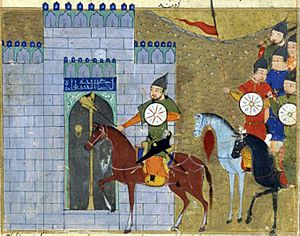
In 1211, after conquering Western Xia, Genghis Khan planned to conquer the Jin dynasty. The Jin army made mistakes. They did not attack the Mongols early on, even though they had more soldiers. Instead, they hid behind the Great Wall. At the Battle of Yehuling, a Jin official switched sides. He gave the Mongols information that helped them defeat the Jin army. Hundreds of thousands of Jin soldiers died. In 1215, Genghis besieged the Jin capital of Zhongdu (modern-day Beijing). The city was captured and sacked. This forced the Jin emperor to move his capital south. The Jin dynasty finally collapsed in 1234 under Genghis's successor.
Taking Over Qara Khitai (1218)
After being defeated by Genghis Khan, Kuchlug, a former Naiman leader, took over the Qara Khitai khanate. Genghis Khan's army was tired from ten years of fighting. So, he sent only 20,000 soldiers under his general Jebe to pursue Kuchlug. With a small force, the Mongols used a new strategy. They encouraged people within Qara Khitai to revolt against Kuchlug. Kuchlug's army was defeated, and he was hunted down and executed. By 1218, the Mongol Empire had expanded west to the borders of Khwarezmia, a large Muslim state.
Conquering the Khwarazmian Empire (1219–1221)

In the early 1200s, the Khwarazmian dynasty was ruled by Shah Muhammad II. Genghis Khan saw Khwarazmia as a good trading partner along the Silk Road. He sent a 500-man trade caravan to start official trade. Genghis Khan and his commanders invested in this caravan, filling it with valuable goods. However, the governor of Otrar, Inalchuq, attacked the caravan. He claimed it contained spies. When Genghis Khan sent three ambassadors to complain, Muhammad II had one of them executed.
Outraged, Genghis Khan planned a huge invasion. He gathered about 100,000 soldiers and his best generals and sons. He left some troops in China and named his family members as his successors. Then, he headed for Khwarazmia.
The Mongols crossed the difficult Altai Mountains in winter, through deep snow. This march was very hard, like Hannibal's crossing of the Alps. Despite losses, the Mongols surprised the Khwarazmian leaders. Genghis Khan sent a group of 20,000-30,000 men under his son Jochi and general Jebe. They raided the fertile Fergana Valley. The Shah sent his best cavalry to stop them, but Jebe and Jochi kept their army strong. They plundered the valley while avoiding defeat.
Meanwhile, another Mongol force under Chagatai and Ogedei besieged Otrar. Genghis kept his main force further back, hoping to trap the Shah. But the Shah avoided the trap. The siege of Otrar lasted five months. Finally, a traitor opened the gates, and the Mongols stormed the city. They killed most of the soldiers. The citadel held out for another month. After it fell, Genghis Khan executed the governor Inalchuq. He killed many inhabitants and enslaved the rest.
Next, Genghis Khan besieged Bukhara. It was not heavily fortified. The city leaders opened the gates to the Mongols. A unit of Turkish defenders held the citadel for twelve more days. Survivors from the citadel were executed. Artisans and craftsmen were sent to Mongolia. Young men who had not fought were drafted into the Mongol army. The rest of the population was enslaved. After Bukhara surrendered, Genghis Khan personally entered the city. He lectured the city's leaders on their wrongdoings.
With Bukhara captured, the Mongols advanced on the capital of Samarkand. This city had stronger defenses and a larger army. The Mongols used psychological warfare, even using captured prisoners as human shields. After several days, only a few soldiers loyal to the Shah remained in the citadel. When the fortress fell, Genghis executed every soldier who had fought against him.
Some historical accounts say that the people of Samarkand and Termez were killed. However, modern archaeology suggests that the Mongols often enslaved conquered people. They sent them to Mongolia for labor or used them in the war effort. This still led to a large decrease in population.
Near the end of the battle for Samarkand, the Shah fled to an island in the Caspian Sea. He died that same year. His son, Jalal al-Din Mangburni, continued to resist. Genghis Khan ordered his generals, Subutai and Jebe, to destroy the remaining Khwarazmian forces.
The rich trading city of Urgench was still held by Khwarazmian forces. The attack on Urgench was the hardest battle of the invasion. The city fell only after a strong defense. Mongol casualties were higher than usual. As was common, artisans were sent to Mongolia. Young women and children were given to Mongol soldiers as slaves. The rest of the population was killed. Some historians say 1.2 million people were killed, but modern scholars find this number too high. Still, the sacking of Urgench was very bloody.
Campaigns in Georgia, Crimea, and Kievan Rus' (1220–1225)
After defeating the Khwarazmian Empire in 1220, Genghis Khan gathered his forces in Persia and Armenia. He planned to return to Mongolia. On the suggestion of Subutai, the Mongol army split into two. Genghis Khan led the main army on a raid through Afghanistan and northern India. Another group of 20,000 soldiers marched through the Caucasus and into Russia. This group was led by generals Jebe and Subutai. They went deep into Armenia and Azerbaijan.
The Mongols defeated the kingdom of Georgia. They sacked the Genoese trade fortress of Caffa in Crimea. They spent the winter near the Black Sea. On their way home, Subutai's forces attacked the combined armies of the Cuman–Kipchaks and the Kievan Rus' troops. At the Battle of Kalka River in 1223, Subutai's forces defeated the larger Kievan army.
These campaigns were like scouting missions. They helped the Mongols understand the regions' politics and cultures. In 1225, both Mongol divisions returned to Mongolia. These invasions added Transoxiana and Persia to the growing empire. Later, under Genghis Khan's grandson Batu, the Mongols returned to conquer Volga Bulgaria and Kievan Rus' in 1237.
Final Campaigns: Western Xia and Jin Dynasty (1226–1227)
The ruler of the Tanguts (Western Xia) had refused to help the Mongols in their war against the Khwarazmian Empire. Western Xia and the defeated Jin dynasty formed an alliance to resist the Mongols. They hoped the Mongols would be too busy in the west to respond.
In 1226, after returning from the west, Genghis Khan launched a revenge attack on the Tanguts. His armies quickly took several cities. One Tangut general challenged the Mongols to battle but was defeated. In November, Genghis besieged the Tangut city of Lingzhou and crossed the Yellow River. He defeated the Tangut relief army. Legend says Genghis Khan saw five stars in the sky, which he took as a sign of victory.
In 1227, Genghis Khan's army attacked and destroyed the Tangut capital. They continued to advance, taking more cities. At Deshun, the Tangut general fought fiercely but died from arrow wounds. Genghis Khan went to Liupanshan to escape the summer heat. The new Tangut emperor quickly surrendered. The rest of the Tanguts officially surrendered soon after. Genghis Khan was not happy with their betrayal. He ordered the entire imperial family to be executed, ending the Tangut royal line.
Genghis Khan's Death and Succession
Genghis Khan died during his last campaign against the Western Xia. He fell ill on August 18, 1227, and passed away on August 25, 1227. The exact cause of his death is a mystery. Some say it was illness, others say he was killed in battle or from a hunting injury. The Secret History of the Mongols says he fell from his horse while hunting. A 2021 study suggested he might have died from bubonic plague.

Years before his death, Genghis Khan asked to be buried without any markings, following his tribe's customs. After he died, his body was returned to Mongolia. He is believed to be buried near the Onon River and Burkhan Khaldun mountain. Legend says the funeral escort killed anyone they met to keep the burial site a secret. The Genghis Khan Mausoleum, built much later, is a memorial, not his actual burial place.
Before he died, Genghis Khan chose Ögedei Khan as his successor. Genghis Khan left an army of over 129,000 men. His brothers and sons received parts of this army. His youngest son, Tolui, inherited over 100,000 men, including most of the elite Mongol cavalry. The title of Great Khan went to Ögedei, his third son. Genghis Khan's oldest son, Jochi, died before his father. His second son, Chagatai, was passed over due to a past argument about Jochi's parentage.
Later, Genghis Khan's grandsons divided his empire into different khanates. His descendants expanded the Mongol Empire across most of Eurasia. They conquered or made vassal states in China, Korea, the Caucasus, Central Asia, and parts of Eastern Europe and Southwest Asia. Many of these invasions involved large-scale killings of local populations.
How Genghis Khan Organized His Empire
Governing the Mongol Empire
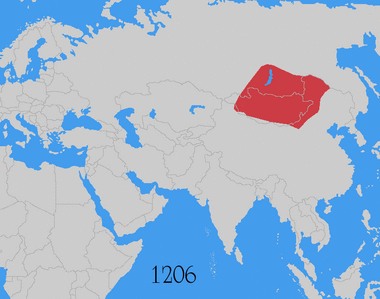
The Mongol Empire was ruled by a set of laws called the Yassa, created by Genghis Khan. The empire did not focus on a person's ethnicity or race for leadership roles. Instead, it used meritocracy, meaning people were chosen based on their skills. The Mongol Empire was very diverse, with many different ethnic and cultural groups. Many nomadic people considered themselves "Mongols" in military and daily life.
Religious figures, teachers, and doctors often did not have to pay taxes. The Mongol Empire allowed different religions. Mongol tradition believed that religion was a personal choice, not something the law should control. Genghis Khan followed Tengrism, but he was tolerant of other religions. He learned from Buddhist monks, Muslims, Christian missionaries, and Daoist monks. This religious tolerance was already common in the Asian steppe.
Genghis Khan tried to create a fair state under the Great Yassa. Some say it aimed for legal equality for everyone, including women. While there is no clear proof of this, women did play important roles in the Mongol Empire. For example, Töregene Khatun briefly held power. The policy of encouraging trade and communication is called the Pax Mongolica. Genghis Khan also saw the need for people to govern the conquered cities. He invited a Khitan prince, Chu'Tsai, who had experience governing. Chu'Tsai became a trusted advisor to Mongol Khans.
Mongol Military Strategies
Genghis Khan trusted his generals completely, like Muqali, Jebe, and Subutai. He saw them as close advisors and gave them many privileges. He allowed them to make their own decisions when they were on campaigns far from the capital. For example, Muqali led forces against the Jin dynasty while Genghis Khan was in Central Asia. Subutai and Jebe were allowed to lead a great raid into the Caucasus and Kievan Rus'. Genghis Khan expected strong loyalty from his generals.
The Mongol military was also good at siege warfare. They would cut off resources to cities by diverting rivers. They used captured enemy prisoners as human shields. They also adopted new ideas and tools from the people they conquered. They used Muslim and Chinese siege engines and engineers to help their cavalry capture cities. Another common Mongol tactic was the feigned retreat. This was used to break enemy formations and lure small enemy groups into an ambush.
Another important part of Genghis Khan's military organization was the communications and supply route, called the Yam. This system helped speed up military intelligence and official messages. Waystations were set up all over the empire for this purpose.
Genghis Khan's Impact on History
Positive Contributions
Genghis Khan is credited with bringing the Silk Road under one political system. This led to more communication and trade between the West, Middle East, and Asia. It expanded the knowledge and cultures of all these areas. Some historians note that Genghis Khan introduced meritocracy in his rule. He was tolerant of different religions and clearly explained his policies to his soldiers. Some European writers in the Middle Ages had a positive view of Genghis Khan, even though they knew little about his empire.
In Mongolia, Genghis Khan has been honored for centuries. He is seen as a symbol of tribal statehood, military organization, and victories. He is a very important figure in Mongolian culture. He is credited with introducing the Mongolian script and creating the first written Mongolian law code, the Yassa.
During the communist period in Mongolia, Genghis Khan was often seen as a negative figure. Positive statements about him were avoided. However, in the early 1990s, his memory was strongly revived. He became a symbol of national identity for many young Mongolians. They believe that historical records written by non-Mongolians are biased against him. They argue that his cruelty is exaggerated, and his positive role is underestimated.
Mixed Views
There are different views of Genghis Khan in China. The population of northern China greatly decreased during his time. However, many deaths were also due to plague, floods, and famine. The Mongols also spared many cities if they surrendered, such as Kaifeng and Hangzhou. Chinese soldiers even joined Genghis Khan against the Jin dynasty.
While Genghis never conquered all of China, his grandson Kublai Khan completed the conquest. Kublai Khan established the Yuan dynasty. He is often credited with reuniting China. There is much Chinese art and literature that praises Genghis as a military leader and political genius. The Yuan dynasty left a lasting impact on Chinese political and social structures.
Negative Impacts
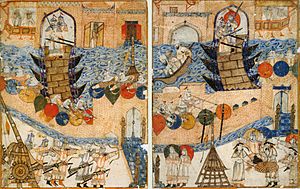
Genghis Khan's conquests and leadership involved widespread destruction and mass murder. Cities that refused to surrender were often punished with enslavement and slaughter. The second campaign against Western Xia, Genghis Khan's final military action, involved destroying Western Xia cities and culture. Because of this, very little record of that society remains. Some historians call this an attempted genocide or a very successful ethnocide, meaning the destruction of a culture.
In the conquest of Khwarezmia, the Mongols destroyed cities like Bukhara and Samarkand. They killed many people in these cities. His invasions are seen as the start of a 200-year period called the "Mongol catastrophe" in Iran and other Islamic societies. Historians from that time described the Mongol invasions as a disaster never seen before. Some modern Iranian historians also view this period as uniquely catastrophic. One historian writes that Mongol violence in the Iranian Plateau "killed up to three-fourths of the population."
The famous Mughal emperors were proud descendants of Genghis Khan. However, they tried to distance themselves from the cruel acts committed by the Mongols. Still, Mughal Emperors directly supported the legacies of Genghis Khan and Timur. Their names were important among Muslim populations in South Asia.
Genghis Khan in Art and Culture
Historical Depictions
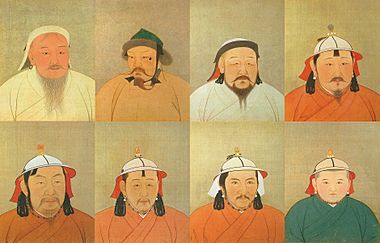
Unlike most emperors, Genghis Khan never allowed his image to be painted or sculpted during his lifetime. The earliest known images of him were made about 50 years after his death. This includes the famous National Palace Museum portrait in Taiwan. This portrait shows Genghis Khan in white robes and a leather cap, with braided hair. It is often thought to be the closest to what he actually looked like. However, it was made after his death.
Other cultures also portrayed Genghis Khan in their own way. In Persia, he was shown as a Turkic sultan. In Europe, he was pictured as a fierce barbarian. A Mongol painter named Ho-li-hosun was asked by Kublai Khan in 1278 to paint the National Palace Museum portrait. The story says Kublai Khan wanted the portrait to show Genghis Khan's true image.
Only two people recorded Genghis Khan's physical appearance during his life. The Persian historian Minhaj al-Siraj Juzjani described him as "a man of tall stature, of vigorous build, robust in body, the hair of his face scanty and turned white, with cats’ eyes." The Chinese diplomat Zhao Hong, who visited the Mongols in 1221, described Genghis Khan as "of tall and majestic stature, his brow is broad and his beard is long."
Later descriptions from the 14th century also exist. The Persian historian Rashid-al-Din wrote that most of Genghis Khan's ancestors were "tall, long-bearded, red-haired, and bluish green-eyed." He said Genghis Khan himself had these features. However, some scholars believe "red-haired" might have meant a ruddy skin color.
Genghis Khan in Modern Culture

Today in Mongolia, Genghis Khan's name and image are everywhere. You can find his face on products, streets, and buildings. His face is on the largest Mongolian money notes. Ulaanbaatar's main international airport is named Chinggis Khaan International Airport. There is also a huge 40-meter-high equestrian statue of Genghis Khan east of the capital. There has been talk about controlling how his name and image are used. Genghis Khan's birthday, on the first day of winter, is a national holiday in Mongolia.
Many books, films, and other works have been made about Genghis Khan and his legacy.
- Literature
- "The Squire's Tale" from The Canterbury Tales by Geoffrey Chaucer is set at Genghis Khan's court.
- Genghis Khan by Vasily Yan, 1939.
- The End of Genghis, a poem by F. L. Lucas.
- The Conqueror series of novels by Conn Iggulden.
- White cloud of Genghis Khan by Chingiz Aitmatov.
- The Private Life of Genghis Khan by Douglas Adams and Graham Chapman.
- Films
- Genghis Khan, a 1950 Philippine film.
- The Conqueror, 1956, starring John Wayne.
- Changez Khan, a 1957 Indian film.
- Genghis Khan, a 1965 film starring Omar Sharif.
- Genghis Khan: To the Ends of the Earth and Sea, a 2007 Japanese-Mongolian film.
- Mongol, a 2007 film directed by Sergei Bodrov.
- No Right to Die – Chinggis Khaan, a 2008 Mongolian film.
- Genghis Khan, a 2018 Chinese film.
- Television series
- Genghis Khan, a 1987 Hong Kong TV series by TVB.
- Genghis Khan, a 1987 Hong Kong TV series by ATV.
- Genghis Khan, a 2004 Chinese-Mongolian TV series.
- Video games
- Temüjin (video game), a 1997 computer game.
- Aoki Ōkami to Shiroki Mejika, a Japanese game series about Genghis Khan.
|
See also
 In Spanish: Gengis Kan para niños
In Spanish: Gengis Kan para niños


